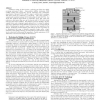Free Online Productivity Tools
i2Speak
i2Symbol
i2OCR
iTex2Img
iWeb2Print
iWeb2Shot
i2Type
iPdf2Split
iPdf2Merge
i2Bopomofo
i2Arabic
i2Style
i2Image
i2PDF
iLatex2Rtf
Sci2ools
DAC
2000
ACM
2000
ACM
Multiple Si layer ICs: motivation, performance analysis, and design implications
Continuous scaling of VLSI circuits is reducing gate delays but rapidly increasing interconnect delays. Semiconductor Industry Association (SIA) roadmap predicts that, beyond the 130 nm technology node, performance improvement of advanced VLSI is likely to begin to saturate unless a paradigm shift from present IC architecture is introduced. This paper presents a comprehensive analytical treatment of ICs with multiple Si layers (3-D ICs). It is shown that significant improvement in performance (more than 145%) and reduction in wire-limited chip area can be achieved with 3-D ICs with vertical inter-layer interconnects (VILICs). This analysis is based on dividing a chip into separate blocks, each occupying a separate physical level. A scheme to optimize interconnect distribution among different interconnect tiers is presented and the effect of transferring the repeaters to upper Si layers has been quantified in this analysis. Furthermore, thermal analysis of ICs with two Si layers is pre...
| Added | 13 Nov 2009 |
| Updated | 13 Nov 2009 |
| Type | Conference |
| Year | 2000 |
| Where | DAC |
| Authors | Shukri J. Souri, Kaustav Banerjee, Amit Mehrotra, Krishna Saraswat |
Comments (0)

